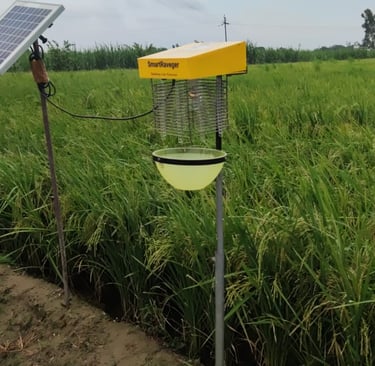Optimizing Rice Production with Innovative IPM Solutions from Ai-Genix
Optimizing Rice Production with Integrated Pest Management Solution from Ai-Genix : A Comprehensive Guide to Understanding and Managing Insect Pests and Diseases for Enhanced Productivity
2/13/20247 min read


Understanding Insect Pests Threats to Rice Crop Production
The management of insects, pests, and diseases is crucial for achieving sustainable rice production. Rice stands as a dietary staple for nearly half of the world’s population and is cultivated in 110 countries, covering about one-fifth of the world’s cropland under cereals. However, its production is significantly affected by attacks from insects, pests, and diseases, resulting in reductions in yield. Approximately 52 percent of global rice production is lost annually due to biotic stress factors, with 21 percent attributed to major insect pests. Analysis of rice insect pests over the past 52 years (1965–2017) reveals a gradual increase in pest numbers, with new pests emerging every 5 or 10 years while existing ones remain problematic.
More than 800 rice insect species have been reported in worldwide ecosystems. Among these, about 700 species are considered benign or beneficial to rice plants, while approximately 100 species are known to attack rice. Of these, around 20 species, including the brown plant hopper, white-backed plant hopper, yellow stem borer, leaf folder, gall midge, rice hispa, and others, are considered major pests causing substantial damage to rice crops.
The National Centre for Integrated Pest Management (NCIPM) identified several major insect pests of national significance in India, including the yellow stem borer, brown planthopper, white-backed planthopper, leaf folder, gall midge, and gundhi bug. Additionally, pests like thrips, panicle mites, and black bugs hold regional importance, particularly in Andhra Pradesh.
Insect pests and the stages at which they attack the rice crop.
Vegetative stage
Seedling maggots (Diptera: Muscidae)
Rice whorl maggots (Diptera: Ephydridae)
Rice caseworms (Lepidoptera: Pyralidae)
Rice green semiloopers (Lepidoptera: Noctuidae)
Rice leaf beetles (Coleoptera: Chrysomelidae)
Rice thrips (Thysanoptera:Thripidae)
Rice gall midge (Diptera: Cecidomyiidae)
Armyworms and cutworms (Lepidopera: Noctuidae)
Grasshoppers, katydids, and field crickets (Orthoptera: Acrididae, Gryllidae, and Tettigoniidae)
Rice leaffolders (Lepidoptera: Pyralidae)
Rice stem borers (Lepidoptera: Pyralidae and Noctuidae)
Stalked-eyed flies (Diptera: Diopsidae) Black bugs (Hemiptera: Pentatomidae) Rice hispa (Coleoptera: Chrysomelidae)
Mealybugs (Homoptera: Pseudococcidae)
Reproductive stage
Greenhorned caterpillars (Lepidoptera: Satyridae)
Rice skippers (Lepidoptera: Hesperiidae)
Planthoppers (Homoptera: Delphacidae)
Leafhoppers (Homoptera: Cicadellidae)
Ripening stage
Ripening seed bugs (Hemiptera: Alydidae)
Stink bugs (Hemiptera: Pentatomidae)
Soil-inhabiting pests
Ants (Hymenoptera: Formicidae)
Termites (Isoptera: Termitidae and Rhinotermitidae)
White grubs (Coleoptera: Scarabaeidae)
Field crickets (Orthoptera: Gryllotalpidae)
Mole crickets (Orthoptera: Gryllotalpidae)
Root weevils (Coleoptera: Curculionidae)
Root aphids (Homoptera: Aphididae)
Wire worms (Coleoptera: Elateridae)
Root-feeding mealybugs (Homoptera: Pseudococcidae)
Furthermore, climate change is expected to impact insect behavior, distribution, and abundance. Changes such as increased number of generations per year, higher winter survival rates, and earlier appearances of insects indicate the influence of climate change. Meteorological factors, as reported by various studies, influence seasonal abundance, distribution, and population growth of insects. For instance, populations of plant hoppers, armyworms, and root weevils thrive under hot, dry, and clear sky conditions, while leaf folders, stem borers, and hispa prefer wet, humid, and cloudy weather conditions.
In conclusion, effective management strategies, considering the dynamic nature of insect behaviour and the impact of climate change, are imperative for sustaining rice production and ensuring food security globally.
Understanding Pathogenic Threats to Rice Crop Production
Diseases pose a significant threat to rice crop production, impacting yield, quality, and overall food security. Various pathogens, including fungi, bacteria, viruses, and nematodes, can infect rice plants, leading to devastating consequences for farmers and economies dependent on rice cultivation. Here's a brief overview of some common diseases affecting rice crop production:
Rice Blast Disease: Caused by the fungus “Magnaporthe oryzae”, blast disease is one of the most destructive rice diseases worldwide. It affects leaves, nodes, panicles, and sometimes roots, causing lesions that eventually lead to plant death. Blast disease can result in significant yield losses, particularly in areas with high humidity and temperatures. Rice blast is a key concern in combating global food insecurity given the disease is responsible for approximately 30% of rice production losses globally-the equivalent of feeding 60 million people. These losses increase the global rice price and reduce consumer welfare and food security
Sheath Blight: This disease is caused by the fungus “Rhizoctonia solani”. Sheath blight affects the sheaths, blades, and nodes of rice plants, leading to characteristic lesions and rotting. It spreads rapidly under warm and humid conditions, causing yield losses and reducing grain quality.
Bacterial Leaf Blight: “Xanthomonas oryzae pv. Oryzae” causes bacterial leaf blight, which affects rice plants at all growth stages. Infected leaves develop water-soaked lesions that turn brown, leading to blighting and death of foliage. Bacterial leaf blight can cause significant yield losses, especially in areas with heavy rainfall and high temperatures.
Rice Tungro Disease: Rice tungro is caused by a combination of two viruses: Rice tungro bacilliform virus (RTBV) and the Rice tungro spherical virus (RTSV). This disease is transmitted by the green leafhopper (Nephotettix virescens). Infected plants show stunted growth, yellowing of leaves, and reduced tillering, ultimately leading to decreased yields.
Rice Blast: Rice blast, caused by the fungus “Pyricularia oryzae," affects all parts of the rice plant, including leaves, stems, panicles, and seeds. Infected plants exhibit spindle-shaped lesions that can coalesce and cause extensive damage, leading to yield losses and grain quality reductions.
Rice Brown Spot: Brown spot is caused by the fungus “Cochliobolus miyabeanus.”. It appears as small, brown lesions on leaves and can lead to premature leaf senescence. While not as destructive as blast or sheath blight, brown spots can still reduce yields, particularly in regions with high humidity and frequent rainfall.
Rice Yellow Mottle Virus (RYMV): This virus causes yellow mottling and stunting of leaves, leading to reduced photosynthesis and yield losses. It is transmitted by infected seed and insect vectors, such as leafhoppers.
Nematode Diseases: Several species of nematodes can infect rice roots, leading to reduced nutrient uptake, stunting, and yield losses. The most common nematode species affecting rice include root-knot nematodes and rice root nematodes.
Growth stages of rice diseases and their pathogens
Seed and Seedling:
Seedling Blight
Seedling Blight (Sclerotium rolfsii, Cochliobolus miyabeanus, Fusarium sp., Curvularia sp., Athelia rolfsii, Rhizoctonia solani, Athelia rolfsii, and other pathogenic fungi.) Fungi
Water Mold (Achlyasp. Pythium sp.) Fungi
Roots and Crown Rot
Crown Rot (Erwinia chrysanthemi) Bacteria
Root Rot (P. dissotocum, Fusarium sp., P. spinosum, and Pythium sp.) Fungi
Root Knot (Meloidogyne sp.) Nematode
Leaf Blades:
Rice Blast (Pyricularia oryzae), Fungi
Brown spot (Bipolaris oryzae), Fungi
Narrow brown leaf spot (Cercospora oryzae), Fungi
Leaf smut (Entyloma oryzae)
Leaf scald (Sarocladium oryzae), Fungi
Bacterial leaf blight (Xanthomonas campestris pv. oryzae) Bacteria
Stackburn (Alternaria padwickii), Fungi
White leaf streak (Mycovellosiella oryzae), Fungi
White tip (Aphelenchoides besseyi), Nematode
Stem and leaf sheath:
Sheath spot (Rhizoctonia oryzae), Fungi
Sheath blight (Rhizoctonia solani), Fungi
Sheath blotch (Pyrenochaeta oryzae), Fungi
Sheath rot (Sarocladium oryzae), Fungi
Crown sheath rot (Gaeumannomyces graminis), Fungi
Stem Rot (Magnaporthe salvinii) Fungi
Flag leaf collar blast (Pyricularia oryzae), Fungi
Node blast (Pyricularia oryzae), Fungi
Tungro (Rice tungro bacilliform virus (RTBV)), Virus
Grassy stunt (Rice Grassy stunt virus (RGSV)) , Virus
Panicle, Florets, and Grain:
Rotten neck blast (Pyricularia oryzae), Fungi
Head blight (Various fungi), Fungi
Panicle blast (Pyricularia oryzae) , Fungi
Bacterial panicle blight (Burkholderia glumae), Bacteria
Downy Mildew (Sclerophthora macrospora), Fungi
Grain spotting or Pecky rice (Fusarium sp., Cochliobolus miyabeanus, Microdochium oryzae, Sarocladium oryzae, Curvularia sp. and bacteria), Fungi and Bacteria
Kernel smut (Tilletia barclayana), Fungi
False smut (Ustilaginoidea virens), Fungi
Bakanae (Fusarium moniliforme), Fungi
Black kernel (Curvularia lunata), Fungi
Safeguarding Rice Crop Production: Combatting Insect Pest and Pathogenic Threats
Integrated Insect Pest Management
For effective insect pest management at Ai-Genix® we have developed series of solution that includes SmartRavager Series, BraveHawk Series and the biological control agents like Chrysoperla carnia are available on commercial basis. Our entry level product SmartRavager-STD/HQ/HQLA is good enough and recommended to manage the most of insect pests of rice effectively.
Integrated Disease Management
For effective disease management at Ai-Genix® we have developed PathoShield: A physical bacterial and fungal pathogen control system. This system works as preventive and control solution for minimizing the impact of bacterial and fungal diseases on rice crop production and ensuring food security for communities dependent on rice as a staple food crop.
For controlling Rice Yellow Mottle Virus (RYMV) disease, it important to choose good quality of seeds as this is seed born disease and further it is propagated by insect vectors, such as leafhoppers, hence controlling the leafhoppers population is very essential, to control the population of hoppers we at Ai-Genix have most effective and efficient insect-pest control device SmartRavager.
As noted above, RTBV is transmitted by leafhoppers only in the presence of RTSV. The major vector is the rice green leafhopper, Nephotettix virescens, and it can also be transmitted by some other leafhopper species such as N. nigropictus, N. malayensis, N. parvus and Recilia dorsalis. Neither of the two viruses is transmissible mechanically. Hence controlling the leafhoppers population is very essential, to control the population of hoppers we at Ai-Genix have most effective and efficient insect-pest control device SmartRavager.
Whereas for management of dieses caused by nematodes, one can make use of biological control agents (fungi) Viz. Paecilomyces, Verticillium, Hirsutella, Nematophthora, Arthrobotrys, Drechmeria, Fusarium and Monacrosporium. Application of some of these fungi has given very interesting results in field condition.
Reference:
Valluri, J.H.V., Cherukuri, Ch., Chiranjeevi, Ch., Rao, V.S and Varma, P.K. 2022. Seasonal incidence of major insect pests of paddy in Krishna Western Delta region of Guntur district, Andhra Pradesh. The Journal of Research ANGRAU. 50(4):20-26
Shubhransu, N., Soma, S., Chandan, S., & Soumya Sephalika, S. (2021). Rice crop loss due to major pathogens and the potential of endophytic microbes for their control and management. Journal of Applied Biology & Biotechnology.
Savary, S., Willocquet, L., Pethybridge, S.J. et al. The global burden of pathogens and pests on major food crops. Nat Ecol Evol 3, 430–439 (2019).
Iqbal, Shazia. (2020). Insect, Pest and Disease Management in Rice.
Nalley L, Tsiboe F, Durand-Morat A, Shew A, Thoma G. Economic and Environmental Impact of Rice Blast Pathogen (Magnaporthe oryzae) Alleviation in the United States. PLoS One. 2016 Dec 1;11(12):e0167295.
Zaki A. Siddiqui, Irshad Mahmood, Biological control of plant parasitic nematodes by fungi: A review,Bioresource Technology, Volume 58, Issue 3, 1996, Pages 229-239,
Poveda J, Abril-Urias P, Escobar C. Biological Control of Plant-Parasitic Nematodes by Filamentous Fungi Inducers of Resistance: Trichoderma, Mycorrhizal and Endophytic Fungi. Frontiers in Microbiology. 2020 May 25; 11:992.
OUR ADDRESS
SH12 | Samarpan | Unique Garden | Beverly Park | Kanakia Layout | Mira Road (E) | Thane | Maharashtra - 401107 | India
CONTACT US
info@ai-genix.com
+91-22-3569 5818
WORKING HOURS
Mon - Fri: 10:00 - 19:00
Sat: 10:00 - 16:00
Sun: Closed
Supported & Funded By









